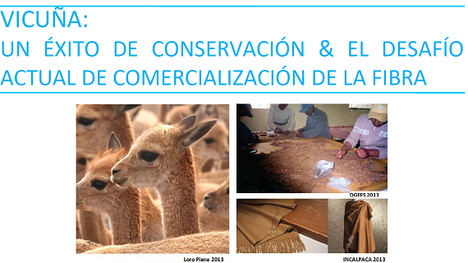Comercio con la fibra más cara del mundo: la vicuña (en)
The wool of the vicuña, a camelid (llama type animal) living at 4000 metres in the Andes is the finest natural fibre in the world. Produced in small quantities, it is used by the luxury end of the fashion industry. ITC is working with several partners including TRAFFIC and IUCN in analysing how to raise the incomes of the indigenous people who look after the vicuña. The project also looks at how to balance the demands of the market with conserving the species from threats of over-use and poaching.
Vicuña: from the Andes to Milan
This week, ITC held a side event on these themes with the Governments of Peru and Ecuador at the CITES 16th meeting of the Conference of parties in Bangkok.
A presentation from Elena Mendoza of the Trade and Environment Programme in ITC showed that the fashion industry create around 96% of the value in the chain with domestic processors adding around 1.5%. The communities that look after and shear the animals for wool capture just 0.5% of the total value. A scarf costs around USD1500 while a man's coat can cost up to USD20,000.
Despite the relatively low value of the wool in Peru (worth USD2m) per year compared to agriculture and mining, the income is valuable to families seeking out a living in the harsh conditions of the Peruvian altiplano. They live at 4000metres and there are few alternative income generating possibilities in these remote villages.
Bernardo Ortiz from TRAFFIC South America spoke by video link from his garden in Quito, Ecuador about how the principal challenge in the vicuña supply chain was “to make the trade benefit communities”.
To address this issue Silvia Velasquez from the Ministry of Agriculture in Peru spoke of training programmes for communities on craft making (to add value) and on improving negotiation skills.
Three Peruvian companies currently buy from the communities and process the fibre to remove grease and dirt and spin it. Some communities had managed to be involved in more of the processing stage through hand cleaning of the wool.
The scope for further value addition is limited by the needs for economies of scale (and high capital and skills investments in machinery) for value addition. Rosie Cuny of IUCN spoke about how communities producing kangaroo meat in Australia had organized themselves into cooperatives in order to strengthen their bargaining position. This helped raise the price for their very low value commodity. Whilst the cooperative tradition is strong in Latin America for example in producing coffee, this would not be straight forward for such remote communities.
In the 1970s, the vicuña was almost hunted into extinction. Following its listing by CITES, the Peruvian Government took the key step in 1994 to give the communities the right to their use of the wool. Whilst the State still owned the animal, the communities overnight had an economic incentive to protect and preserve it. Since then the population in the region has grown to 400,000 animals.
In the wake of this conservation success in Peru, Ecuador took similar steps to protect its own vicuña population. The CITES meeting this week agreed to allow Ecuador to export the wool like Peru and Bolivia. It was initially listed as an Appendix I species, ie. banned from international trade but transferred to Appendix II at Committee I of CITES CoP16.
Teddy Escarabay from the Ministry of Ecuador spoke about how his country still had to make it easier for the communities to use their own natural resources as there are many restrictions on using local wildlife. A successful model would be eco-tourism around Ecuador’s highest volcano Chimborazo.
Juan Carlos Vasquez from the CITES Secretariat saw four key factors explaining the success of the vicuña’s recuperation from near extinction. These were the strong engagement from Governments, the assignment of “use rights” to the communities of the skins, a strong enforcement regime and international and regional cooperation.
In his final words, Juan Carlos endorsed ITC, TRAFFIC, UNEP-WCMC and IUCN to work in partnership to share this success story with the rest of the conservation and trade communities.
Back to the main page of ITC environment blog.
You can also follow Alex on Twitter.




